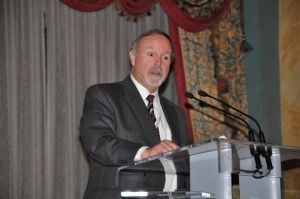

Lunch Keynote: Mike Ritter, Technical Solutions Engineer, PSO Mobile, Google, talks about iPhone vs. Android. Says that 80% of Google staffers carry iPhones. 80% of management carries Blackberries. The remaining 20% of both carry both. Interesting note: iPhone delivers 10 – 50x more advertising revenues.
Mike talks about his past failures. Lists all the companies he has worked at that have gone bankrupt. One of them is in the process of going bankrupt. Then, he takes a shot a Sun: “Don’t know why it’s not bankrupt”.
Mike’s Top 10 reasons for why startups fail.
Mike’s Top 10 reasons for startups succeed.
Mike’s Top 10 Inflection Points:
10: Universal Translators
9. Search engines understand what you want to know
8. Augmented Memory (PDAs, etc)
7. Machines learn how to learn.
6. Nano-machines assemble themselves
5. Computing and communications essentially free. (cheap now, will be free in the future. Value will be in the content communicated)
4. People live their whole lives off of the earth (the moon! Google SpaceX)
3. We understand the programming language of DNA
2. We understand how the rest of the body works.
1. We understand how the programming of the brain works.
Top 10 areas ripe for startups:
10. Cloud & Mobile Computing
9. Harnessing the power of the crowd.
8. Personalized Mobile Services
7. Voice recognition & understanding in real-time.
6. Improving energy efficiency
5. Robots (Both Large and Small)
4. Renewable Energy
3. On-demand manufacturing
2. Machine learning
1. Immortality (health & life sciences)
Thoughts on cloud computing.
Top 10 problems Mike needs solved.
Afternoon session:
Pierre La Lann: CEO, Tribalnova.com
Venture Financing Without Borders: Cross-Border investing – Neal Hill, Great Northern Capital; Bill Bryant, DFJ; Steve Hnatiuk, Yaletown Venture Partners; Charles Lax, GrandBanks Capital.
The question to the panel: will you invest in a company that is not within a 45 minute drive or a 2 hour direct flight?
Charles Lax, GrandBanks Capital: Yes, but only if the deal is syndicated to a local firm. Coaching is essential. If they are the lone investors, the venture has to be in Boston.
Steve Hnatiuk, Yaletown Venture Partners: Proximity is more essential in the seed round, when companies need a lot of coaching. There is more confidence in the strategic direction of firms by the time they raise their series A, so going outside their region is a bit easier at a later stage.
Bill Bryant, DFJ: international firm: 2 day rule, instead of 2 hour rule. DFJ has investments in 20 companies, and need to take advantage of the opportunities outside of the US.
Other interesting comments: Get ready for a long relationship: average time to exit from Series A: 8.3 years. Don’t value your early rounds too high: 70% of all deals exited at under $150M – unlying the reason why VCs look for valuations around $10M – 15M, looking for 10x returns.
I received a starter deck from Akoha’s Austin Hill. Pictured is Christina Paganelli, with the first Akoha game card mission that I completed: donate 1 hour of time. I’ve spent some time advising Christina’s company, Sunflower Organics. Now Christina gets to continue passing on the Karma.























